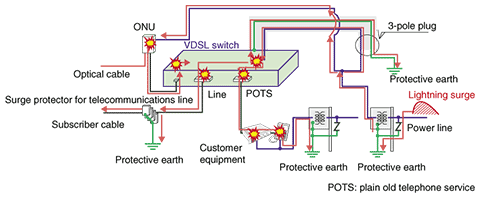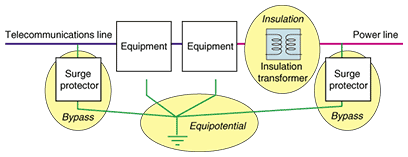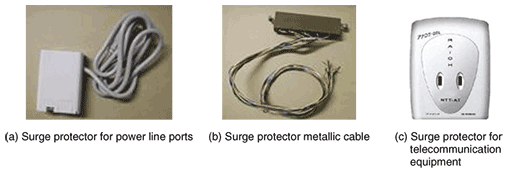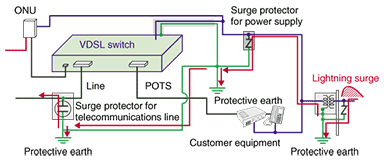 |
|||
|
|
|||
|
Special Feature on Technical Solutions to Real-world Problems Vol. 6, No. 11, pp. 27–30, Nov. 2008. https://doi.org/10.53829/ntr200811sf1 Lightning Surge Mitigation Measures for VDSL SystemsAbstractThis article describes the mechanism by which VDSL (very high bitrate digital subscriber line) systems are damaged by lightning and introduces effective mitigation measures and products. Since the wide-spread use of broadband telecommunication services has been accompanied by an increasing number of lightning-related problems in telecommunication equipment, this is becoming an important issue. We focus on VDSL systems that are widely used as a solution for providing FTTH services to apartment buildings.
1. Growth of FTTH service and need for lightning protection measuresThe number of fiber-to-the-home (FTTH) subscribers in Japan has been increasing rapidly in parallel with the rapid spread of broadband telecommunication services. In the B FLET'S Mansion Type, which is one of the broadband services for apartment buildings, optical fiber is used as a transmission medium up to the entrance of an apartment building. Then data is carried by VDSL (very high bitrate digital subscriber line) signals over metallic cables within the building up to individual apartments. The system must therefore perform optical-to-electrical signal conversion at the optical network unit (ONU) in the common-use area and overlay the PSTN (public switched telephone network) line at the VDSL. Since metallic cables are used in addition to optical fiber, the system is vulnerable to lightning surges even when providing an FTTH service. In the following sections, we describe mitigation measures for protecting VDSL systems against lightning surges. 2. Damage caused by lightning in VDSL systemsConsidering that a VDSL concentrator includes multiple metallic-cable connections, the invasion of a lightning surge will result in the formation of inflow/outflow paths for the surge current via the VDSL concentrator and ONU, which will cause faults to occur, as shown in Fig. 1. This figure shows a schematic of surge-current flow paths assuming that the lightning surge invades through the AC power line. Surge current flow paths will be formed and damage will occur in a similar manner even if the lightning surge should enter from a telecommunication cable or grounding line.
3. Basic approaches of lightning protection measuresThree basic approaches can be considered as protection measures against lightning in a VDSL system connected to both metallic cables and a AC power line (Fig. 2).
The first approach is an equipotential scheme whereby the potentials of equipment, metallic cables, and the power line are all made the same. In this scheme, all grounding systems, such as those for telecommunications, power, or protection, are connected to one common ground. Here, metallic cables and the AC power line are grounded via surge protectors (such as arresters or varistors), so they are not connected directly to ground. Thus, since the potentials of all devices are equal, any lightning surge that invades the system will be unable to flow through these devices. Consequently, they are protected from damage caused by the lightning. The second approach is a bypass. In this scheme, a circuit that bypasses telecommunication devices is made. By using surge protectors, such as arresters and/or varistors, the telecommunication line and the power line are connected to a common grounding system. This method is called the bypass arrester method because the bypass circuit is configured using surge protectors. In the event of a lightning-surge invasion through one of the interfaces, the lightning surge current will flow through the bypass circuit via a surge protector, and the path to the other interface will be cut off, thereby protecting the internal circuits of the equipment. The third approach is insulation. This method, in contrast to those above, prevents the invasion of a lightning surge. Specifically, it inserts an insulation transformer in the power line or metallic cable, which prevents a lightning surge from passing. When this method is used, a lightning surge will cause a high voltage to be generated at both sides of the transformer, so the insulation voltage resistibility of such an insulation transformer must be made high. This requirement, however, inevitably makes the transformer relatively large and expensive. Considering the need for an economical and space-saving configuration, we decided to use the equipotential and bypass methods in combination and exclude insulation as a protection measure for the VDSL concentrator. 4. Protection measures for a VDSL concentratorThe following lightning protection products can be used to configure bypass circuits as protection measures for a VDSL concentrator (Fig. 3).
(1) Surge protector for power line ports (Fig. 3(a)) (2) Surge protector metallic cable (Fig. 3(b)) (3) Surge protector for telecommunication equipment (Fig. 3(c)) An example of a lightning protection scheme when customer equipment and a VDSL concentrator share the same power supply is shown in Fig. 4. The bypass circuits are configured by installing a surge protector for power-supply use and a surge protector for telecommunications use. The surge protector for power-supply use can be selected according to the number of power outlets needed and the number of power-plug poles (2 or 3). The existing subscriber arrester is utilized as the surge protector for telecommunications use. Next, to achieve an equipotential configuration, the ground terminals of the VDSL concentrator, surge protector for power-supply use, and subscriber arrester are connected in common. The ground line connecting the subscriber arresters to the VDSL concentrator and surge protector for power-supply use is made as short as possible to enhance the lightning protection effect. As a result of the above measures, the surge protector for power-supply use operates whenever a lightning surge from the AC power supply occurs. This will cause current from the surge to flow through the bypass circuit while maintaining equipotential conditions between equipment, thereby protecting the VDSL concentrator. The same sort of protection can be given to the VDSL concentrator even for the invasion of a lightning surge via metallic cables. The facility configuration shown in Fig. 4 is normally used and is the most popular type of protection measure. Deploying just this facility pattern should reduce the amount of lightning-related damage or number of malfunctions within the target area. Economical protection measures can also be achieved by using only a surge protector at a power supply line and a ground line.
In the real world, a variety of facility configurations can be considered. For example, the VDSL concentrator and VDSL modem may not share the same power-supply system, or the subscriber arrester on the telecommunications line may be far away or even not installed. Therefore, it is necessary to check detailed information about the system's configuration. Procedures for evaluating appropriate mitigation measures can be found in the Manual on Lightning Protection Measures published by the Technical Assistance and Support Center in NTT East. Moreover, the web page of that center has a troubleshooting database. Therefore, it will help you to solve problems caused by lightning. 5. ConclusionAs the number of VDSL subscribers rises, the reliability of the telecommunications network has become an issue of prime importance. Protection measures against lightning are one of the key issues for supporting secure and safe ICT networks (ICT: information and communications technology). This article introduced protection measures for only VDSL concentrators. Even when the networks migrate from PSTN to IP (Internet protocol) with optical fiber technologies, the risk of damage due to lightning cannot be ignored. The Technical Assistance & Support Center (TASC) at NTT East aims to develop lightning protection technologies corresponding to each service and to recommend suitable countermeasures for facilities that are damaged by lightning. |
|||











